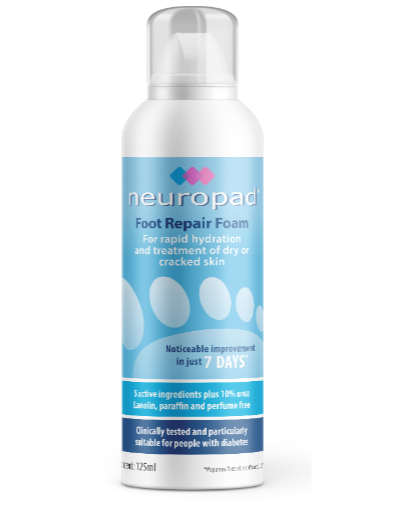neuropad® Foot Repair Foam
neuropad® Foot Repair Foam is an emollient (moisturiser) specially developed to help protect your feet by keeping them soft and hydrated, helping the external layers of the skin to become softer and more pliable. It is free from lanolin and perfume, is non-greasy, and contains natural plant extracts.
Each day, your feet are subjected to a great deal of physical stress. If you have diabetes, you may be particularly at risk of damaging your feet.
Why? Because lack of sweating and, eventually, lack of feeling mean that you may not detect damage to your feet until it has become quite serious and requires specialist treatment.
neuropad® Foot Repair Foam is an emollient (moisturiser) which has been specially developed to help protect your feet by keeping them soft and hydrated, helping the external layers of the skin (epidermis) to become softer and more pliable.
Emollients are used to smooth the surface of the skin and to increase hydration. Neuropad® Foot Repair Foam improves the binding of water to the skin, because it contains 10% urea. Urea also has a neutral pH, meaning it is neither acidic nor alkaline1.
The application of moisturisers containing humectants such as lactic acid, urea, glycerin and alpha-hydroxy acids helps with the repair of dry skin and enhances the skin barrier function.

Has neuropad® Foot Repair Foam been clinically studied?
Although not classed as a medical product, it has been studied clinically with positive results.3,4
For example, in a recent study4 involving 53 patients, aged 68 ±11 years, of whom 70% had previously used other footcare products the following results were published.
Has neuropad® Foot Repair Foam been clinically studied?
Although not classed as a medical product, it has been studied clinically with positive results.3,4
For example, in a recent study4 involving 53 patients, aged 68 ±11 years, of whom 70% had previously used other foot care products the following results were published.

| Hydrates | Exfoliates | Regenerates | Elasticates | |
|---|---|---|---|---|
| Urea 10% | ||||
| Oenothera Biennis Oil | ||||
| Extract Centella Asiatica | ||||
| Panthenol | ||||
| Alpha Hydroxy Acid | ||||
| Allantoin |
Full list of ingredients
Aqua, Urea, Caprylic/Capric Triglyceride, Butane, Stearic Acid, Propane, Persea Gratissima Oil, Cetyl Alcohol, Stearyl Alcohol, Sodium Lactate, Glycerin, Sorbitan Stearate, C12-15 Alkyl Benzoate, Methyl Glucose Sesquistearate, Cocamidopropyl Betaine, Lactic Acid, Alcohol Denat., Sodium Benzoate, Menthol, Menthyl Lactate, Panthenol, Tocopheryl Acetate, Isobutane, Potassium Sorbate, Allantoin, Oenothera Biennis Oil, Butylene Glycol, Glycolic Acid, 2-Bromo- 2-Nitropropane-1,3-Diol, Centella Asiatica Extract, Retinyl Palmitate, Citric Acid, Helianthus Annuus Seed Oil, Tartaric Acid, Tocopherol, Sodium Hydroxide, Sodium Chloride.
How to apply
Shake well before use. Always keep canister upright in use and lightly press the applicator to produce a 1-2cm diameter ball of foam. Massage foam gently into the skin. Apply regularly to prevent dryness from developing.

Contraindications, cautions and interactions
Do not use if you believe you are sensitive to any of the ingredients. Do not use on children under 5 years of age. Do not apply near the eyes or mucus membranes and do not inhale the contents. For external use only. Urea may increase the penetration of other products into the skin. Please seek medical advice if you are using any other topical products.For example, in a recent study4 involving 53 patients, aged 68 ±11 years, of whom 70% had previously used other footcare products the following results were published.
References
- Kottner J, Lichterfeld A, Blume-Peytavi U. Maintaining Skin Integrity in the Aged: A Systematic Review. British Journal of Dermatology. 2013; Sept 16913.
- Loden M. Urea-containing moisturizers influence barrier properties of normal skin. Arch Dermatol Res. 1996;288:103-7.
- Pagrach B, Ruys I, Effect of repair moisturizing foam in the treatment of dry skin of the diabetic foot, 2011.
- Papanas N et al. Evaluation of a new foot foam to increase skin hydration of the foot in type 2 diabetes: a pilot study. Int Wound J. 2011 Jun;8(3):297-300.
- Ullah OM, et al. Antimicrobial, cytotoxic and antioxidant activity of centella asiatica. Eur J Sci Res. 2009;30:260-4.
